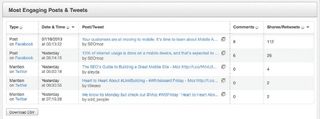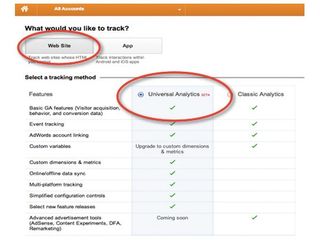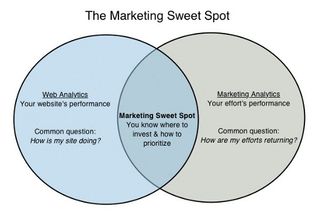Why you need marketing analytics to build your online brand
Web analytics isn’t enough any more, argues Ruth Burr. She explains the importance of using marketing analytics to build a brand online.
I think we can all agree that the days of thinking you don't need a website to build a brand are pretty much behind us. Businesses today are more and more aware of the power the internet has to bring in new customers and also increase the number and quality of long-term customer relationships.
Measuring and improving on-site performance is a key component of a successful online marketing strategy, which is why most businesses use web analytics tools such as Google Analytics to track site performance. However, in modern web marketing, the website itself may be merely the last step in a longer customer journey.
The rise of search sessions
One classic limitation of web analytics is that of purchase attribution: in many cases, credit for a sale or other conversion is given solely to the last marketing the customer experienced before buying. This ignores the way that most people gather information online. The decision to make a purchase online may involve any or all of the following:
- Multiple web searches
- Browsing review information
- Asking friends' advice on social media channels
- Reading content on trusted informational sites
- Creating 'ideas boards' on sites such as Pinterest
Instead of an individual web search, purchasing decisions are made using these search sessions, which may take place over several days and multiple web properties. To reach consumers during every step of the buying funnel, marketers need to build a brand presence on third-party websites and social media. Top brands that do so are reaping the benefits.

Why, then, with all of the time, effort and resources we put into online marketing, would we limit our data collection to what happens on our own sites?
Web vs marketing analytics
Web analytics will always be important to measuring online success. Having a web analytics tool such as Google Analytics on your site is a vital first step for any web marketing campaign; without it, you'll be completely in the dark about what visitors to your website do once they get there.
Web analytics tools have grown increasingly robust over time. Earlier this year, Google Analytics announced the rollout of Universal Analytics, which enables users to track visitor activity across multiple platforms and even within web apps.
Get the Creative Bloq Newsletter
Daily design news, reviews, how-tos and more, as picked by the editors.
However, at the heart of web analytics tools is visitor analytics. Visitor analytics are meant to tell you everything they can about what visitors do once they come to your site. You can receive a limited amount of data on where these visitors came from, but the main question that web analytics is designed to answer is, 'How is my website doing?'
That's an important consideration, yet it's not the only thing marketers should be asking. Our marketing efforts start long before a visitor makes it to our website. Our measurement should do the same. We need to answer the question: 'What kind of return am I getting for my marketing efforts?'

Enter marketing analytics: the measurement and optimisation of your marketing activities. Marketing analytics goes beyond on-site data and brings in other tools and offsite metrics to take a holistic approach to marketing.
Web analytics is invaluable for short-term gains; making improvements to the visitor experience is a great way to get more out of the budget you're already spending. With marketing analytics, you have the added benefit of seeing which of your efforts are paying off long-term, enabling you to plan your budget most effectively.
The metrics of marketing analytics
Both web and marketing analytics concern themselves with conversions or sales, revenue and return on investment (ROI). In neither case should these be the only key performance indicators (KPIs) to measure success. Just as web analytics KPIs would also include things like number of visitors, time on page and conversion rates, marketing analytics has its own set of KPIs. These will be different for different campaigns, but may include such things as:
- Conversion rate and ROI by specific channels and campaigns
- Results of conversion rate optimisation tests
- Shares, likes and retweets grouped by content type and topic
- Number of engaged followers on a social platform versus number of total followers
- Signups for emails, webinars and similar outreach efforts
As well as being a channel for new customer acquisition and growth, marketing should be a channel for existing customer retention and loyalty - and analytics efforts should reflect that. Marketing metrics for retention and loyalty may include:
- Lifetime customer value following a new lifecycle campaign
- Percentage of repeat or recurring customers
- Traffic and conversions from existing customers after an upsell or win-back campaign
As marketers spend more time measuring our off-site and offline efforts, competitive analysis can't be forgotten. What are your competitors doing? What's working for them? Where are they spending time, money and effort to gain visibility? These are things web analytics simply can't tell us, but it's key information in terms of knowing where you stand and where you should or shouldn't be investing.

The web is, in many ways, a marketplace. It's not enough for marketers to be doing the best they can to serve customers on-site; they also need to be positioning their brands against competitors' and focusing on customer relationships and their unique brand proposition, throughout the web.
The future of online marketing
Modern online marketing involves a more holistic approach than in the industry's fledgling years. The idea that one person can build a site, another can write content, and another can 'do SEO' to the whole thing once it's complete is dinosaur thinking.
Online marketing as an industry needs to shift in this direction. After all, you can't build links or drive social media traffic to a site without content, but you won't make any money by creating content if nobody's around to read it, or if nobody can find what they want on the site. Breaking down silos between roles on a web marketing team will be a huge asset to that team's success.
The sweet spot
Here are some ways different members of a marketing team can use marketing analytics and web analytics together for maximum success:
- Match up the demographic data of your Facebook followers with the content they're most likely to consume. Then, work with your user experience and development team to create new user paths for those users.
- Track where users are discussing your brand online. Join the conversation and measure the traffic and conversions from the results.
- Measure what forms of content get most shares, comments and engagement on different social platforms (such as Facebook, Google+ and Twitter) and then launch different campaigns for each platform reflecting that user group's preferences.
- Consult with your 'help' team to find out your current customers' biggest problems and most frequently asked questions about your product. Create engaging web experiences to help answer those questions. Run an email campaign to let customers know about the new experience, then track the resulting impact on customer retention.

When you're tracking how your marketing efforts affect users off-site as well as on, you're targeting all points of the buying process, filling the top of your customer funnel to keep the conversions and sales coming in. Best of all, you can track 'fuzzy' metrics (like the number of Twitter followers you've gained) back to the ultimate ROI in both dollars and brand loyalty those efforts have.
Words: Ruth Burr Image: James Oconnell
Ruth Burr is a senior SEO at Moz and related properties FollowerWonk.com and GetListed. James Oconnell is a Manchester-based designer and illustrator who communicates thought-provoking ideas with informed aesthetics.
This article originally appeared in net magazine issue 246.
Liked this? Read these!
- Our favourite web fonts - and they don't cost a penny
- The top website builder tools
- How to create an app: try these great tutorials

Thank you for reading 5 articles this month* Join now for unlimited access
Enjoy your first month for just £1 / $1 / €1
*Read 5 free articles per month without a subscription

Join now for unlimited access
Try first month for just £1 / $1 / €1
The Creative Bloq team is made up of a group of design fans, and has changed and evolved since Creative Bloq began back in 2012. The current website team consists of eight full-time members of staff: Editor Georgia Coggan, Deputy Editor Rosie Hilder, Ecommerce Editor Beren Neale, Senior News Editor Daniel Piper, Editor, Digital Art and 3D Ian Dean, Tech Reviews Editor Erlingur Einarsson and Ecommerce Writer Beth Nicholls and Staff Writer Natalie Fear, as well as a roster of freelancers from around the world. The 3D World and ImagineFX magazine teams also pitch in, ensuring that content from 3D World and ImagineFX is represented on Creative Bloq.
